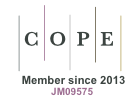Mniaecia jungermanniae and Puttea margaritella (lichenized Ascomycota) found in Poland
Abstract
Keywords
Full Text:
PDFReferences
Stenroos S, Laukka T, Huhtinen S, Döbbeler P, Myllys L, Syrjänen K, et al. Multiple origins of symbioses between ascomycetes and bryophytes suggested by a five-gene phylogeny. Cladistics. 2009;26(3):281–300. http://dx.doi.org/10.1111/j.1096-0031.2009.00284.x
Hyde KD, Soytong K. The fungal endophyte dilemma. Fungal Divers. 2008;33:163–173.
Rodriguez RJ, White JF, Arnold AE, Redman RS. Fungal endophytes: diversity and functional roles. New Phytol. 2009;182(2):314–330. http://dx.doi.org/10.1111/j.1469-8137.2009.02773.x
Pressel S, Bidartondo MI, Ligrone R, Duckett JG. Fungal symbioses in bryophytes: new insights in the twenty first century. Phytotaxa. 2010;9:238–253.
Raspe O, De Sloover JR. Morphology, ecology and chorology of Mniaecia jungermanniae (Ascomycota) in Belgium and the significance of its association to leafy liverworts (Jungermanniales). Belg J Bot. 1998;131(2):251–259.
De Sloover JR. Présence en Belgique de Mniaecia nivea et M. jungermanniae (Ascomycota: Leotiales). Lejeunia. 2001;166:1–13.
Pressel S, Duckett JG. The parasitic ascomycete Mniaecia jungermanniae induces the formation of giant perichaetia and apogamous sporophytes in leafy liverworts. Can J Bot. 2006;84(3):384–392. http://dx.doi.org/10.1139/b06-004
Stenroos S, Huhtinen S, Lesonen A, Palice Z, Printzen C. Puttea, gen. nov., erected for the enigmatic lichen Lecidea margaritella. Bryologist. 2009;112(3):544–557. http://dx.doi.org/10.1639/0007-2745-112.3.544
Zając A. Atlas of distribution of vascular plants in Poland (ATPOL). Taxon. 1978;27(5–6):481. http://dx.doi.org/10.2307/1219899
Cieśliński S, Fałtynowicz W. Note from editors. In: Cieśliński S, Fałtynowicz W, editors. Atlas of the geographical distribution of lichens in Poland. Cracow: W. Szafer Institute of Botany, Polish Academy of Sciences; 1993. p. 7–8.
Hardtke HJ. Zum vorkommen von Mniaecia jungermanniae (Nees ex Fr.) Boud. in Sachsen. Z Mykol. 1994;60(1):199–202.
Coppins BJ, Chambers SP. Mniaecia Boud. (1885). In: Smith CW, Aptroot A, Coppins BJ, Fletcher A, Gilbert OL, James PW, et al., editors. The lichens of Great Britain and Ireland. London: British Lichen Society; 2009. p. 611–612.
Benkert D, Otte V. Mniaecia jungermanniae und Podophacidium xanthomelum, zwei seltene Arten der Leotiales (Ascomycetes) in Brandenburg. Verh Bot Ver Berl Brandenbg. 2006;139:187–193.
Hallgrímsson H, Eyjólfsdóttir GG. Íslenskt sveppatal. I. Smásveppir. Fjölrit: Náttúrufræðistofnun Íslands; 2004. (Fjölrit Náttúrufræðistofnunar; vol 45).
Eckblad FE. Bidrag til Vestlandets soppflora. Blyttia. 1975;33:245–255.
Eriksson OE. The non-lichenized ascomycetes of Sweden. Umeå: Department of Ecology and Environmental Science, Umeå University; 2009.
Strijbosch H. Mniaecia jungermanniae (Nees apud Fr.) Boud., een ascomyceet op levende levermossen. Coolia. 1972;15:95–99.
Shultheis B, Tholl MT. Journées luxembourgeoises de mycologie vernale 2001. Bull Soc Nat Luxemb. 2003;104:21–39.
Lichen-forming and lichenicolous fungi in herbarium CBFS. Herbarium materials of Vondrak J. [Internet]. 2013 [cited 2013 Feb 26]; Available from: http://botanika.prf.jcu.cz/lichenology/data.php
Maurer W, Poelt J, Reidl J. Die Flora des Schöckl-Gebietes bei Graz (Steiermark, Österreich). Mitt Abt Bot Landesmus Joanneum Graz. 1983;11–12:1–104.
Hafellner J. Ein Beitrag zur Flechtenflora für die Naturräume Weststeirisches Hügelland, Sausal und Windische Bühel (Steiermark). Fritschiana. 2003;43:47–63.
Hafellner J. Zur Diversität lichenisierter und lichenicoler Pilze im Gebiet der Koralpe (Österreich: Kärnten und Steiermark, Slowenien). Mitt Naturwiss Vereines Steiermark. 2008;138:29–112.
Tretiach M. Further additions to the Italian lichen flora. Cryptogam Mycol. 2004;25(2):173–183.
New York Botanical Garden. Mycology collections portal [Internet]. 2013 [cited 2013 Feb 26]; Available from: http://mycoportal.org/portal/taxa/index.php?taxon=16158&taxauthid=1&cl=North%20America
Czarnota P, Guzow-Krzemińska B. A phylogenetic study of the Micarea prasina group shows that Micarea micrococca includes three distinct lineages. Lichenologist. 2009;42(1):7. http://dx.doi.org/10.1017/S0024282909990211
Sérusiaux E, Brand AM, Motiejunaite J, Orange A, Coppins BJ. Lecidea doliiformis belongs to Micarea, Catillaria alba to Biatora, and Biatora ligni-mollis occurs in Western Europe. Bryologist. 2010;113(2):333–344. http://dx.doi.org/10.1639/0007-2745-113.2.333
Spribille T, Pérez-Ortega S, Tønsberg T, Schirokauer D. Lichens and lichenicolous fungi of the Klondike Gold Rush National Historic Park, Alaska, in a global biodiversity context. Bryologist. 2010;113(3):439–515. http://dx.doi.org/10.1639/0007-2745-113.3.439
DOI: https://doi.org/10.5586/asbp.2013.014
|
|
|







